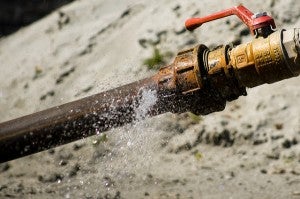How Energy-Water Data Can Help Cities Conserve Both, on World Water Day and Beyond
 Today is World Water Day, an international observance of water’s importance. This year’s theme is “Water and Jobs,” bringing awareness to the fact that nearly half of all workers on Earth (about 1.5 billion people) work in water-related jobs, and virtually all jobs depend on water in some way.
Today is World Water Day, an international observance of water’s importance. This year’s theme is “Water and Jobs,” bringing awareness to the fact that nearly half of all workers on Earth (about 1.5 billion people) work in water-related jobs, and virtually all jobs depend on water in some way.
In conjunction with 2016 World Water Day, the nation’s capital is hosting the White House Water Summit. The President has called on organizations from around the country to voluntarily take new, specific, and measurable steps to address key water issues, such as drought or flooding, water availability, water-use efficiency, and water security. EDF heeded that call and made the following commitment:
Environmental Defense Fund (EDF) is announcing a partnership with Pecan Street, Inc. to gather data and conduct analysis to help 50 households in Houston and Austin understand the connection between their water and energy use. Results of this analysis will help Houston and Austin reduce the water and energy footprint of the more than 3 million utility customers in the two cities. In addition, EDF will work with the University of Texas at Austin, the University of Texas at San Antonio, and the University of California, Davis to help water providers of three to five major Texas cities better manage the energy use embedded in their water systems, with an additional one or two states to be announced later this year.
The work laid out here addresses the issue of embedded energy in water systems, or, in other words, the electricity it takes to secure, deliver, treat, distribute, and heat water. (This is part of what’s known as the “energy-water nexus”.)
That amount varies from place to place, and national data is inconsistent. 2012 research by the University of Texas’ Webber Energy Group established a 2010 baseline for estimated water-related energy use of 12.6 percent across the U.S. That’s a huge amount of power, equivalent to the annual electricity consumption of 40 million Americans. A related study found Texas’ water sector is responsible for about 15 percent of statewide electricity usage. Similarly large numbers have been found for other states that have reported data, such as New York, Massachusetts, Wisconsin, and Iowa. Finally, the best energy-water data is from California, which found that about 20 percent of the state’s electric use was in the water sector – and this figure could be higher now since the analysis was completed in 2005, well before the onset of the current drought.
The problem is, much of this information is based on estimates. That’s why EDF is embarking on work to quantify, at the city level, how much energy water systems actually use – on both the utility and the customer side.
Armed with this data, utilities can develop better water conservation programs that simultaneously reduce energy use and bills, helping them remain financially secure. (Electric costs are often the highest cost water utilities incur other than labor.) More accurate energy-water data will also enable water utilities to prioritize crumbling infrastructure upgrades to address the biggest energy users, such as areas prone to leaks. On the customer side, homeowners will be able to better target their conservation and efficiency measures so they can reduce both energy and water use.
As we gather data from cities, we can also roll that information up to the state level and try to find policy solutions that look at energy and water conservation holistically. In the face of increasing pressure on our electric and water resources, overcoming the silo-ed approach to these two critical resources is an essential step toward more comprehensive solutions. By considering energy and water together, we will begin to see efficiencies that help both sectors, reduce costs, and find opportunities that may not have been apparent otherwise.
On this World Water Day, looking through the lens of the energy-water nexus, we might just find our glass half-full.
The White House Water Summit will be held from 9:00 a.m. EDT to approximately 12:30 p.m. EDT and be livestreamed at www.whitehouse.gov/live.
Photo source: Flickr/Horst Gutmann











3 Comments
Organizations must include thorough planning and testing and include provisions
for business continuity plan policy defnition (ow.ly) continuity.
Great article:-). Best regrads for Author!
Thanks for the feedback and for visiting Energy Exchange!